
A Century of Progress International Exposition, also known as the Chicago World's Fair, was a world's fair held in the city of Chicago, Illinois, United States, from 1933 to 1934. The fair, registered under the Bureau International des Expositions (BIE), celebrated the city's centennial. Designed largely in Art Deco style, the theme of the fair was technological innovation, and its motto was "Science Finds, Industry Applies, Man Conforms", trumpeting the message that science and American life were wedded. Its architectural symbol was the Sky Ride, a transporter bridge perpendicular to the shore on which one could ride from one side of the fair to the other.

A world's fair, also known as a universal exhibition or an expo, is a large global exhibition designed to showcase the achievements of nations. These exhibitions vary in character and are held in different parts of the world at a specific site for a period of time, typically between three and six months.

The Centennial International Exhibition, officially the International Exhibition of Arts, Manufactures, and Products of the Soil and Mine, was held in Philadelphia from May 10 to November 10, 1876. It was the first official world's fair to be held in the United States, and coincided with the centennial anniversary of the Declaration of Independence's adoption in Philadelphia on July 4, 1776.
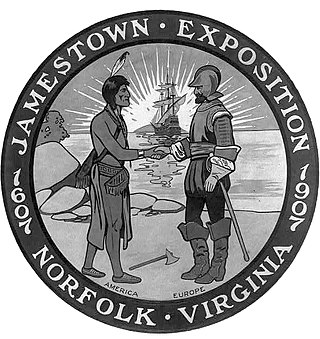
The Jamestown Exposition, also known as the Jamestown Ter-Centennial Exposition of 1907, was one of the many world's fairs and expositions that were popular in the United States in the early part of the 20th century. Commemorating the 300th anniversary of the founding of Jamestown in the Virginia Colony, it was held from April 26 to December 1, 1907, at Sewell's Point on Hampton Roads, in Norfolk, Virginia. It celebrated the first permanent English settlement in the present United States. In 1975, the 20 remaining exposition buildings were included on the National Register of Historic Places as a national historic district.

The Tennessee Centennial and International Exposition was an exposition held in Nashville from May 1 – October 31, 1897 in what is now Centennial Park. A year late, it celebrated the 100th anniversary of Tennessee's entry into the union in 1796. President William McKinley officially opened the event from the White House, where he pressed a button that started the machinery building at the fair; he would visit in person a month later.

Fair Park is a recreational and educational complex in Dallas, Texas, United States, located immediately east of downtown. The 277-acre (112 ha) area is registered as a Dallas Landmark and National Historic Landmark; many of the buildings were constructed for the Texas Centennial Exposition in 1936.

The State Fair of Texas is an annual state fair held in Dallas at historic Fair Park. The fair has taken place every year since 1886 except for varying periods during World War I and World War II as well as 2020, due to the COVID-19 pandemic. It usually begins the last Friday in September and ends 24 days later. The fair claims an annual attendance of over two million visitors through ticket scanning. The State Fair of Texas is considered one of the best in America as well as Dallas' signature event despite its troubled history.

Robert Lee Thornton Sr. was an American banker, civic leader, and four-term Mayor of Dallas, Texas.
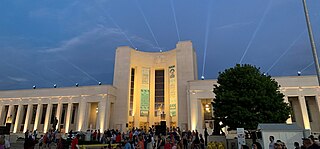
The Hall of State is a building in Dallas's Fair Park that commemorates the history of the U.S. state of Texas and is considered one of the best examples of Art Deco architecture in the state. It was designed and built for the Texas Centennial Exposition.

Paul Philippe Cret was a French-born Philadelphian architect and industrial designer. For more than thirty years, he taught at a design studio in the Department of Architecture at the University of Pennsylvania.
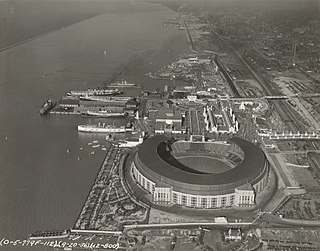
The Great Lakes Exposition was held in Cleveland, Ohio, in the summers of 1936 and 1937, along the Lake Erie shore north of downtown. The fair commemorated the centennial of Cleveland's incorporation as a city. Conceived as a way to energize a city hit hard by the Great Depression, it highlighted the progress that had been achieved in the Great Lakes region in the last 100 years and indicated the path for future progress. Covering over 135 acres of Cleveland's lakefront, it featured numerous attractions, including rides, sideshows, botanical gardens, cafes, art galleries, and much more. Similar to the Chicago World's Fair, the exposition also wanted to expose visitors to other countries' cultures, celebrate American industry, and promote local businesses. Although the Great Lakes Exposition was not as much of a world fair as the Chicago World's Fair was, the exposition drew 4 million visitors in its first season, and 7 million by the end of its second and final season in September 1937—a total of 13 million visitors.
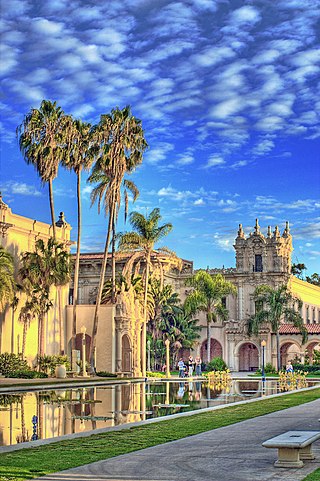
The California Pacific International Exposition was an exposition held in San Diego, California during May 29, 1935–November 11, 1935 and February 12, 1936–September 9, 1936. The exposition was held in Balboa Park, San Diego's large central urban park, which had also been the site of the earlier Panama-California Exposition in 1915.
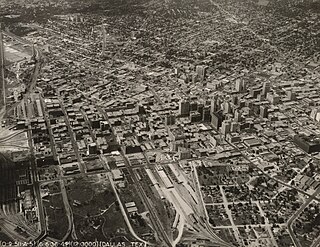
The history of Dallas, Texas, United States, from 1930 to 1945 documents the city's emergence from the Great Depression, its economic boom after several local oil discoveries, its hosting of the Texas Centennial Exposition, and its existence during wartime.

Raoul Jean Josset was a French-born American sculptor. He was born in Tours.
The Greater Texas & Pan-American Exposition was a World's Fair held at Fair Park in Dallas, Texas (USA). The exhibition promoted the city of Dallas as the cultural and economic capital of an emerging Pan-American civilization stretching from Tierra del Fuego to Alaska. It followed the successful Texas Centennial Exposition, which was held to celebrate the centennial anniversary of Texas in 1936. Every exhibition building constructed for the 1936 fair were simply redecorated for the event, but most major exhibitors did not return in 1937. The event also included the Pan American Olympics, pitting the nations of North, Central, and South America against one another in a series of interracial contests and which led as a precursor for the eventual establishment of the Pan American Games.

Antonio Maceo Smith was a civil rights leader in Dallas, Texas, whose years of activism with the National Association for the Advancement of Colored People (NAACP) and other civil rights and community groups led Texans to dub him "Mr. Civil Rights" and "Mr. Organization".
A centennial, or centenary in British English, is a 100th anniversary or otherwise relates to a century, a period of an exact century.

Allie Victoria Tennant was an American sculptor born in St. Louis, Missouri, the daughter of Thomas Richard and Allie Virginia Brown Tennant. She worked primarily out of Dallas, Texas, where her most famous work Tejas Warrior was produced for the Hall of State at the Texas Centennial Exposition.

The Appalachian Exposition, also known as the Appalachian Exhibition, was an event held in 1910 and 1911 in Knoxville, Tennessee's on property owned by Knoxville Railway and Light. The park grounds were 65 acres and included two lakes. The exhibitions demonstrated progress in Southern industry. Former president Theodore Roosevelt spoke at the 1910 exposition, and president William Howard Taft spoke in 1911.

The American Negro Exposition, also known as the Black World's Fair and the Diamond Jubilee Exposition, was a world's fair held in Chicago from July until September in 1940, to celebrate the 75th anniversary of the end of slavery in the United States at the conclusion of the Civil War in 1865.





















